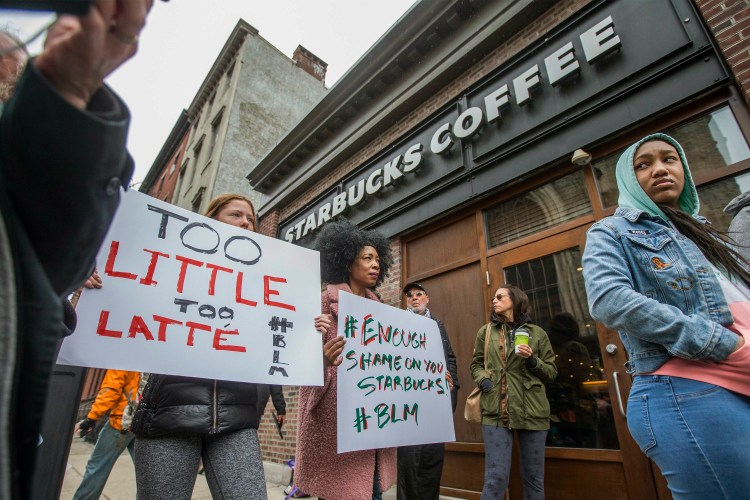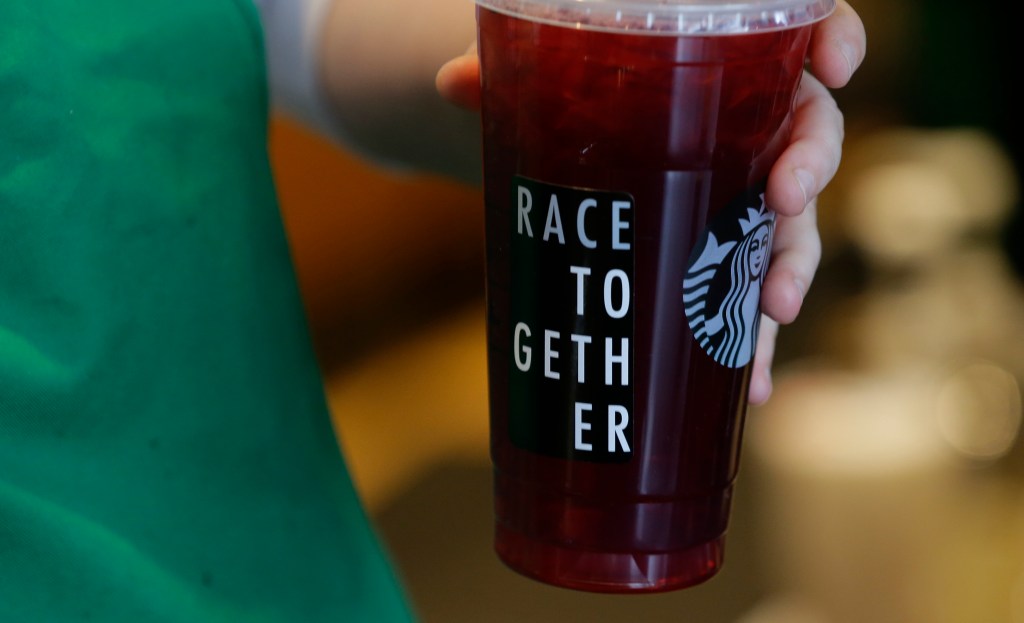Starbucks, trying to tamp down a racially charged uproar over the arrest of two black men at one of its stores in Philadelphia, plans to close more than 8,000 U.S. stores for several hours next month to conduct racial-bias training for nearly 175,000 workers.
The announcement Tuesday comes after the arrests sparked protests and calls for a boycott on social media. A video shows police talking with two black men seated at a table. After a few minutes, officers handcuff the men and lead them outside as other customers say they weren’t doing anything wrong. Philadelphia-area media said the two were waiting for a friend.
Starbucks, which once urged its employees to start conversations about race with customers, found itself through the looking glass, under fire for its treatment of black people.
The company reacted from a high level: Starbucks CEO Kevin Johnson called the arrests “reprehensible” and said he wanted to apologize to the two men face to face. The company and a lawyer for the two men said they did meet, and Johnson delivered the apology. Starbucks also said the employee who called police no longer works at the store, but declined to give details.
Johnson had also promised to revamp store management training to include the “unconscious-bias” training. Starbucks said Tuesday the company-owned stores and corporate offices will be closed on the afternoon of May 29 for the training. In addition to the company-owned stores,
Starbucks had as of January about 5,700 licensed stores in the United States, such as the ones inside Target and Barnes & Noble stores.
The company said the training is “designed to address implicit bias, promote conscious inclusion, prevent discrimination and ensure everyone inside a Starbucks store feels safe and welcome.”
The episode highlights the risks large corporations run when they tie their brands so closely to social messaging. In 2015, then-CEO Howard Schultz shrugged off the ridicule that the “Race Together” message drew and pressed on with his public efforts to engage in the debate over race in America. Johnson was scrambling to keep the Philadelphia incident from shattering the message that Starbucks is a corporation that stands for something beyond profit.
“The more your brand is trying to connect emotionally to people, the more hurt people feel when these kinds of things happen,” said Jacinta Gauda, the head of the Gauda Group, a New York strategic communications firm affiliated with the Grayling network. “They are breaking a promise. That’s what makes it hurt deeper.”
Beyond racial relations, Starbucks has staked much of its brand on its dual promise of providing good customer service and treating its employees well, said John Gordon, a restaurant industry analyst with Pacific Management Consulting Group. The Seattle-based company has a reputation for well-managed stores, “a point of difference that allows them to sell primarily drinks and coffees that have a higher cost,” he said.
But in a multinational company with more than 28,000 stores worldwide, there has “to be a situation every day where some human being handles things wrong. You can’t have that many employees and not have something stupid happen,” Gordon said. “Even with a huge operations manual that lays out what to say and what to do, you can’t cover everything.”
Still, Starbucks has set its own high bar.
Last month, the company claimed it had achieved 100 percent pay equity across gender and race for all its U.S. employees and committed to doing the same for its overseas operations, an initiative publicly backed by equality activist Billie Jean King. The company also touts the diversity of its workforce, saying minorities comprise more than 40 percent of its employees in the U.S.
In 2016, Starbucks promised to invest in 15 “underserved” communities across the country, trying to counter an image of a company catering to a mostly white clientele. One of those stores opened in Ferguson, Missouri, the scene of the 2014 protests that erupted following the police shooting of Michael Brown, one of several such killings that moved Schultz to launch the Race Together campaign.
Those efforts were in stark contrast to the video that went viral over the weekend. The hashtag #BoycottStarbucks trended on Twitter, and protesters took over the Philadelphia shop, chanting slogans like, “A whole lot of racism, a whole lot of crap, Starbucks coffee is anti-black.”
“I watched the video, which was hard to watch,” Johnson said. “That is not what Starbucks is about. That is not representative of our mission, our values and our guiding principles.”
Gauda, who has developed workplace inclusion and diversity strategies for corporate clients, cautioned that any unconscious-bias training should not be treated as “special subject” but incorporated as a core part of its employee training. She warned Starbucks against treating Philadelphia as a one-off affair, urging the company to investigate whether there were any warning signs.
“I would suspect that this particular issue is something that has occurred before,” Gauda said. “The company is in crisis mode now, but they should not look at this as an isolated issue.”
Gauda and other corporate communications experts said they were impressed that Johnson immediately took a hands-on approach to addressing the crisis, saying his efforts would pay off in an age where corporations are under the glare of social media.
“I’m actually surprised he is handling it the way a CEO should be handling it. He went in head first and he took the blame for it,” said M.J. McCallum, vice president and creative director of Muse Communications, an advertising and communications agency with an African-American focus. “I definitely applaud that. Most people won’t jump on the bomb.”
“Starbucks has a great reputation. They stand for a better culture. They have stores in inner cities,” McCallum said. “I think he realizes what this one incident can do for his brand.”
Send questions/comments to the editors.




Comments are no longer available on this story